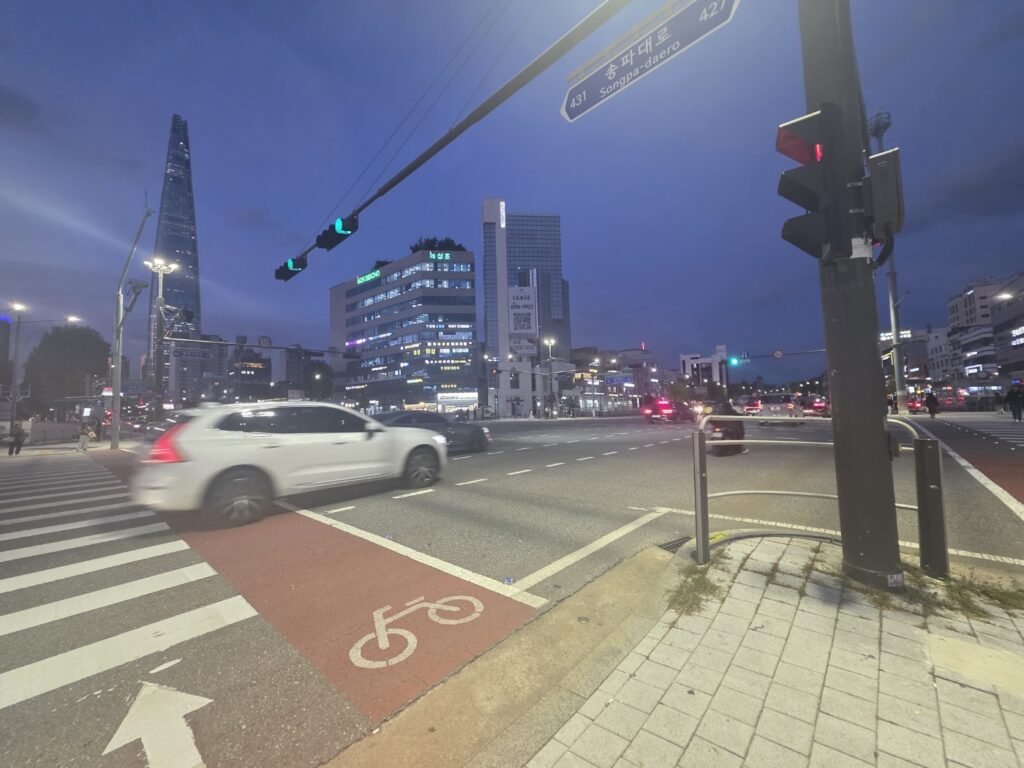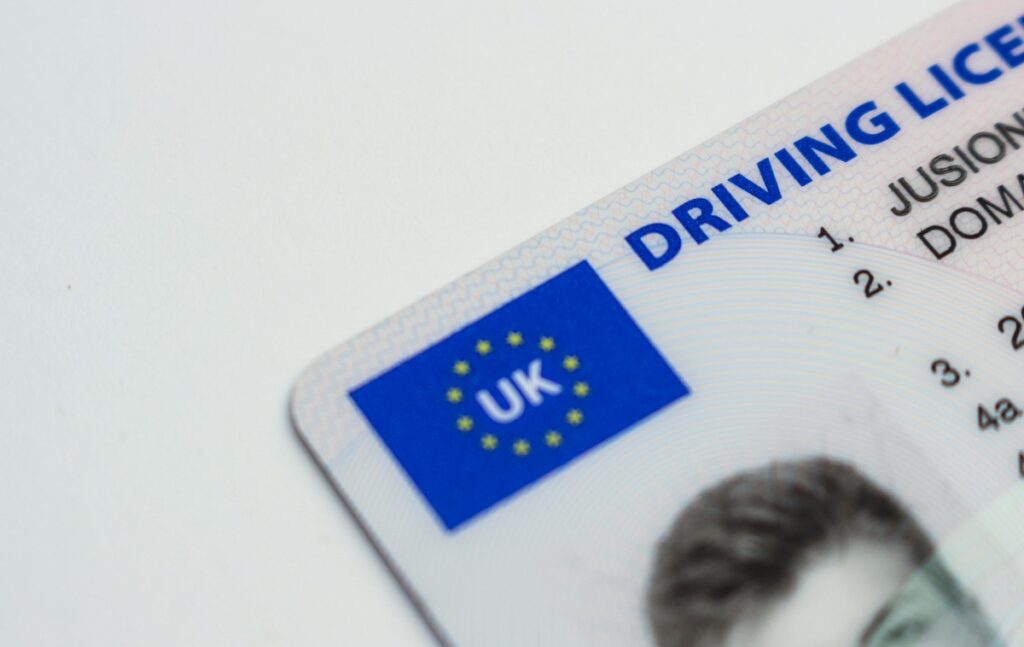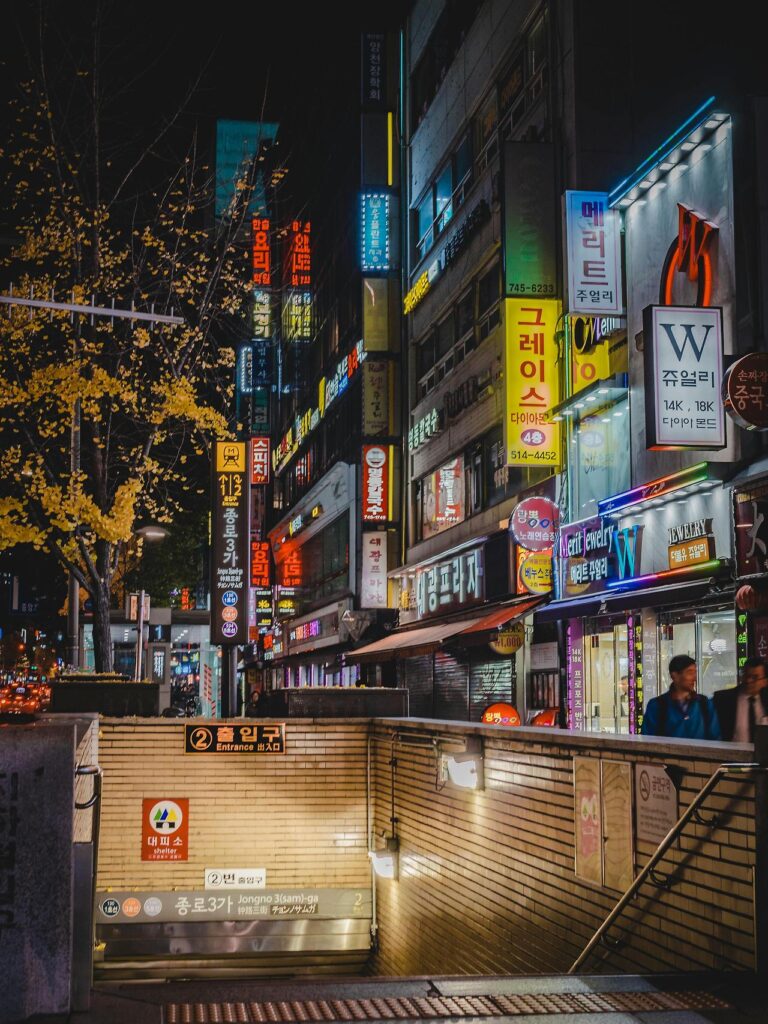Seoul at Night: The City That Glows for Pedestrians
When the sun sets in Seoul, the city doesn’t sleep — it shines. Neon signs flicker, streetlights cast their amber glow, and digital billboards dance across glass towers. Yet, amid this vibrant urban rhythm, one of the most fascinating sights is surprisingly simple: the crosswalk.
For locals, crossing the street is second nature. For visitors, it’s a glimpse into Korea’s remarkable fusion of technology, safety, and civic discipline. Every crosswalk in Seoul tells a story — not just of urban movement, but of a culture that values order, respect, and awareness in shared spaces.

Smart Crosswalks: Where Innovation Meets Everyday Life
In Seoul, the crosswalk isn’t just a painted set of lines; it’s a smart traffic system integrated into the city’s digital infrastructure.
Most intersections feature LED countdown timers that tell pedestrians exactly how many seconds they have to cross — usually between 15 to 30 seconds, depending on the road width.
At night, LED floor lights glow in sync with traffic signals — green when it’s safe, red when it’s not. This helps even smartphone-distracted pedestrians (a known issue everywhere in the world) to notice changes in signal colors without lifting their eyes.
And then there’s the sound. You’ll hear soft beeps and rhythmic tones guiding visually impaired citizens safely across. These auditory cues are universal, so even if you don’t speak Korean, you’ll know exactly when to move.
Jamsil: Where Seoul’s Modern Traffic Culture Shines Brightest
Walk through Jamsil, near Songpa-daero or Lotte World Tower, and you’ll witness some of the most advanced examples of Seoul’s crosswalk technology.
Wide intersections are equipped with motion sensors, reflective bike lanes, and LED-lit pavements. As cars stream past, pedestrians wait calmly — no rushing, no honking, no chaos. When the green figure lights up, people move together in quiet synchrony.
It’s an unspoken choreography of urban harmony: citizens, technology, and infrastructure moving as one.
At some intersections in Jamsil, underground crosswalks even connect directly to subway stations and shopping complexes, offering safety and convenience — especially during Seoul’s snowy winters and humid summers.
The Psychology of the Green and Red Lights
In most Western cities, pedestrians often take a chance — darting across as soon as traffic slows, even before the light turns green.
In Seoul, that’s not the norm.
Here, the red light truly means stop, and people respect it. The green light (초록불), on the other hand, isn’t just a signal — it’s permission granted by collective trust. When the figure turns green, people don’t hesitate; they know cars will stop. This mutual respect between drivers and pedestrians is part of Korea’s civic DNA.
Crosswalk signals even display the remaining time in seconds, creating a sense of calm precision. You won’t see pedestrians sprinting at the last second — most wait patiently for the next cycle.
This may seem like a small detail, but it reflects something profound: in Seoul, public order is seen as a form of respect — for others’ time, safety, and space.
Pedestrian Manners and Unwritten Rules
If you want to blend in like a local, here are a few things to know about crossing the street in Seoul:
- 🚶♀️ Wait behind the tactile line.
You’ll notice a row of yellow, textured tiles at the edge of the sidewalk — that’s the warning strip. Standing behind it shows courtesy and keeps you safe. - 🚲 Bicycles must be walked across the crosswalk.
This surprises many foreigners, but in Korea, you cannot ride your bike across. You must dismount and walk it. Riding through a crosswalk is both unsafe and illegal. - 🟢 Don’t rush during the green light.
You’ll have enough time. Seoul’s timers are generous, and locals prefer steady walking to sudden running. - 🔴 Never cross on a red light, even if there are no cars.
Cameras are everywhere, and jaywalking can result in fines. More importantly, it’s seen as socially irresponsible. - 🧑🤝🧑 Stay in your lane.
Crosswalks often have separate sections for pedestrians and bicycles — follow the markings to avoid confusion.
This quiet discipline creates a sense of collective rhythm that makes walking in Seoul feel safe, orderly, and even therapeutic.
The Smart Tech Behind Safety
Seoul’s smart crosswalks use sensors that detect motion, light conditions, and crowd density. When more people are waiting to cross — for example, during rush hour near Gangnam Station or Jamsil Lotte Tower — the pedestrian light stays green a bit longer.
In some neighborhoods, such as Songpa-gu, the city has tested AI-powered crosswalks that automatically extend the green light for elderly pedestrians or children moving slowly.
Even the LED floor strips are designed with purpose:
- Red = stop (visible even if you’re looking down at your phone)
- Green = walk
- Flashing = hurry up or wait
The result is a network of human-centered technology that makes walking at night as safe as it is during the day.

Seoul vs. Other Cities: What Makes It Different
Let’s compare Seoul’s pedestrian culture with other major cities:
| Aspect | Seoul | New York / London / Tokyo |
|---|---|---|
| LED floor lights | Common at major intersections | Rare or experimental |
| Countdown timers | Visible at nearly all crossings | Limited use |
| Audio signals | Standard nationwide | Partial (mainly near schools) |
| Crosswalk etiquette | Strictly observed | Often ignored or flexible |
| Bike crossing rules | Must walk bikes | Often allowed to ride across |
| Traffic camera enforcement | Ubiquitous | Moderate |
| Underground crossings | Common in dense areas | Rare or outdated |
Seoul’s pedestrian system blends precision engineering with social mindfulness.
It’s less about controlling people and more about encouraging mutual awareness — an elegant example of urban design that respects human nature.
Songpa-daero: A Living Example of Urban Safety
Songpa-daero, the main artery cutting through Jamsil, is a showcase of how technology can coexist with community.
Tall glass buildings shimmer against the twilight, while pedestrians wait at wide, LED-lit crossings.
The traffic lights hum softly, the countdown glows — 20… 19… 18… — and then, as the green figure blinks to life, dozens of people move together in unison. Cars idle without a single honk.
It’s a scene that might seem ordinary to Seoulites but mesmerizing to visitors — the embodiment of order amid energy.
Cultural Symbolism: Respect in Motion
Crossing the street in Seoul isn’t just about getting from one side to another — it’s a small act of collective civility.
Everyone, from teenagers in school uniforms to elders carrying groceries, moves in sync. Drivers yield without complaint.
The city feels alive, yet calm — and that’s what makes Seoul different.
In many ways, the crosswalk is a metaphor for Korean society: structured, considerate, and technologically forward, yet deeply human at its core.

A Walk Worth Taking
Next time you find yourself near Jamsil Station, Songpa-daero, or even Gangnam-daero, stop for a moment before you cross. Watch the lights flicker, the LED line glow, and the crowd move together when the signal turns green.
That single moment captures everything beautiful about Seoul — its innovation, discipline, and quiet poetry of movement.
Conclusion: The Future of Walking Starts Here
Seoul’s crosswalks may look like ordinary urban infrastructure, but they’re far more — they are symbols of smart design and shared humanity.
By merging technology, accessibility, and cultural etiquette, Seoul has redefined what it means to walk safely in a city.
Whether you’re in Jamsil or Hongdae, crossing at night or during rush hour, you’ll feel it — the rhythm, the respect, and the reassurance that you’re walking through one of the safest cities on Earth.
🌐 External Reference
For more about Seoul’s pedestrian innovation, visit:
Seoul Smart City Official Portal (smart.seoul.go.kr)

